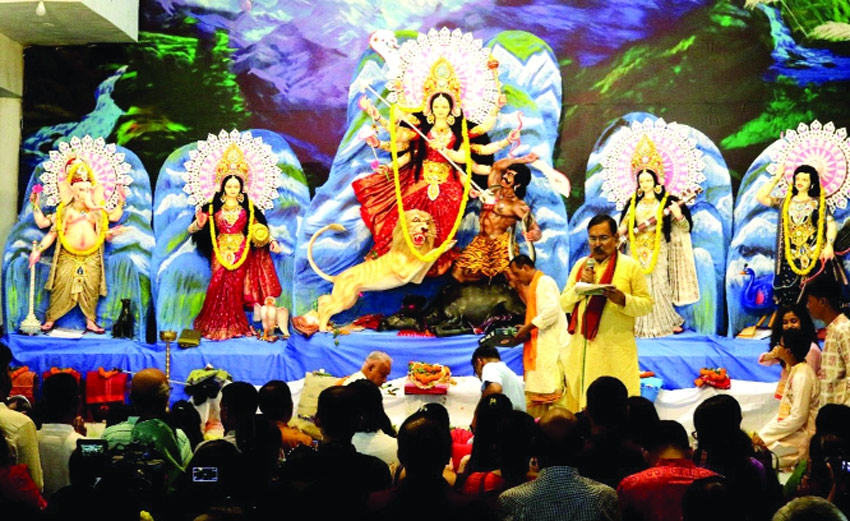Published: 07:56 AM, 30 September 2025
Durga Puja: Maha Saptami celebrated amid due religious fervor and gaiety

Maha Saptami, the second day of the five-day Sharadiyo Durga Puja, was celebrated on Monday amid due religious fervor and gaiety.
Temples and makeshift mandaps witnessed huge devotees and visitors as beautifully crafted idols of Goddess Durga were installed formally on Maha Shasthi on Sunday.
Though puja began from Maha Shasthi, devotees started visiting puja pandals and mandaps yesterday (the day of Maha Saptami).
Dressed in traditional red and white color sharee and panjabi, huge number of devotees were seen visiting puja pandals across the country last evening.
Temples and mandaps have been illuminated and decorated gorgeously marking the puja.
Temples and mandaps have been illuminated and decorated gorgeously marking the puja.
Earlier, Maha Saptami puja was held across the country in the morning as nabapatrika, nine plants including a banana tree tied together and wrapped in a white saree with red borders, were bathed in the water of nearby rivers or ponds (the holy Ganges) and later placed next to Lord Ganesha.
Some Bangalees call it 'Kolabou' (the banana-bride) and it is regarded by many as one of the wives of Lord Ganesha. But this is actually not one of Ganesha's wives. It is considered a representation of Goddess Durga.
It is also known as 'Nabapatrika' as nine plants are tied together to form it and each plant represent the nine forms of the goddess -Brahmani (banana), Kalika (colocasia), Durga (turmeric), Kartiki (jayanti), Shiva (wood apple), Raktadantika (pomegranate), Sokrahita (ashoka), Chamunda (arum) and Lakshmi (paddy).
Maha Saptami puja was offered later to Goddess Durga at temples and makeshift mandaps countrywide followed by offering of Anjali to Goddess by devotees who kept fasting till the puja.
Later, prashad (food and water offered to a deity during worship), was distributed among devotees.
Identical rituals were also held at all temples countrywide including the capital Dhaka.
The annual five-day Sharadiyo Durgotsab commenced with Kalparambho on Sunday (September 28) and it will end with immersion of idols on the day of Bijoya Dashami on October 2.
Maha Ashtami, the third day of the Sharadiyo Durgotsab, will be celebrated today.
On Maha Ashtami, different rituals including offering of Anjali and Kumari Puja will be held in the morning.
Kumari Puja means worshipping of a prepubescent girl as the living incarnation or avatar of Maa Durga. She is dressed in new clothes and dressed up in floral ornaments. This ritual has its origins in the Puranas.
Like previous year, special security arrangements have been made across the country including the capital this year to celebrate Durga Puja in a peaceful atmosphere.
Durga Puja is an annual festival celebrated in September or October, most notably in Kolkata, in West Bengal of India, but also in other parts of India and amongst the Bengali diaspora. It marks the ten-day worship of the Hindu mother-goddess Durga. In the months preceding the festival, small artisanal workshops sculpt images of Durga and her family using unfired clay pulled from the Ganga River. The worship of the goddess then begins on the inaugural day of Mahalaya, when eyes are painted onto the clay images to bring the goddess to life. It ends on the tenth day, when the images are immersed in the river from where the clay came. Thus, the festival has also come to signify 'home-coming' or a seasonal return to one's roots. Durga Puja is seen as the best instance of the public performance of religion and art, and as a thriving ground for collaborative artists and designers. The festival is characterized by large-scale installations and pavilions in urban areas, as well as by traditional Bengali drumming and veneration of the goddess. During the event, the divides of class, religion and ethnicities collapse as crowds of spectators walk around to admire the installations.
>>Agency



